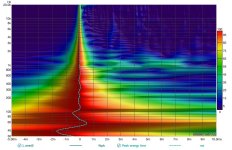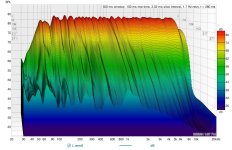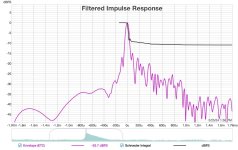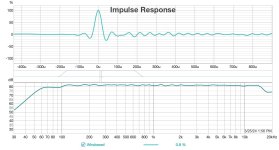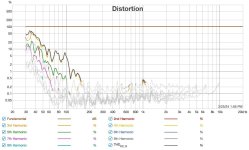Sorry, I did not. I just winged it but made them a bit longer than I thought was neccesary in order to be able to experiment with just the aspect you mention. I even got 4 so I could ruin a pair in the process 🙂
I installed them and find them impoving the sound - for now I'm just enjoying them - but when the cold winter sets in I think I will investigate and measure to know more...
I would guess the more parallel the walls are, the more good they do... so not so long probably.. Maybe they are even worse if too long?
//
I installed them and find them impoving the sound - for now I'm just enjoying them - but when the cold winter sets in I think I will investigate and measure to know more...
I would guess the more parallel the walls are, the more good they do... so not so long probably.. Maybe they are even worse if too long?
//
Hi TNT,
thank you for the reply. I think that I will make them longer and then cut them off as I measure.
Kindest regards,
M
thank you for the reply. I think that I will make them longer and then cut them off as I measure.
Kindest regards,
M
My thought as well - please report if you would be so kind. Perhaps best in the original ATH thread...
//
//
Okey I'm back true to the concept architecture and play the WGs with the Topping HP amp. Now for some reason it works wonders 🙂
Changes are: the "fins" and but also now FIR EQ. FIR is in two steps; FR + phase. And made individually per channel.
It now looks like this in the sweet spot: (I have made one per for a bit a lowballs lift - REW, as usual, ignores the extremes....)

They sound full, resolved and relaxed... jipiie 🙂 so bloody fun!
Still a little small stage for me but I have started to ignore that and just enjoy the frickin' swing these have. They reproduce music in a very happy way and even at times, in a tear producing manner...
//
Changes are: the "fins" and but also now FIR EQ. FIR is in two steps; FR + phase. And made individually per channel.
It now looks like this in the sweet spot: (I have made one per for a bit a lowballs lift - REW, as usual, ignores the extremes....)
They sound full, resolved and relaxed... jipiie 🙂 so bloody fun!
Still a little small stage for me but I have started to ignore that and just enjoy the frickin' swing these have. They reproduce music in a very happy way and even at times, in a tear producing manner...
//
Get a matching bottom end, to fill in the ~30 to 80 Hz, the bottom end is a great "atmosphere" generator!
(especially if you manage to keep it functioning in Stereo)
(especially if you manage to keep it functioning in Stereo)
I know. But I have to care for the poor neighbours. I have 2 pcs of subs sitting in the closet just waiting. I do have surprisingly good bass so no problem att all.
If I measure with PN, I don't see the fall - rather it is increasing all the way to 20Hz. I'm not sure I have that measurement but that what it showed. I'm not sure why these two methods show so great difference in the bass - anyone? is it the reverbation energy that is integrated over a much longer time the for a sweep?
I did play them considerable louder than I have done before - that kind of made them bloom and there was a greater stage.
//
If I measure with PN, I don't see the fall - rather it is increasing all the way to 20Hz. I'm not sure I have that measurement but that what it showed. I'm not sure why these two methods show so great difference in the bass - anyone? is it the reverbation energy that is integrated over a much longer time the for a sweep?
I did play them considerable louder than I have done before - that kind of made them bloom and there was a greater stage.
//
I notice the raise in volume as a determinant factor in stage perception too. But more of a mechanic to get more into the music, the louder I play it.
As if you're moving yourself towards the music 🙂 (or the music to you) when raising the volume. I use JRiver's volume leveling (using R128) and play at a predetermined level.
(85 to 87 dB c-weighting on average, which isn't all that loud if it's clean enough)
A properly EQ-ed bottom end with no obvious room modes left (peaks EQ-ed down) isn't all that loud or bothersome for neighbors i.m.h.o.
Though, to be honest, I'm living in a semidetached home with corridors towards each other, which helps greatly.
As if you're moving yourself towards the music 🙂 (or the music to you) when raising the volume. I use JRiver's volume leveling (using R128) and play at a predetermined level.
(85 to 87 dB c-weighting on average, which isn't all that loud if it's clean enough)
A properly EQ-ed bottom end with no obvious room modes left (peaks EQ-ed down) isn't all that loud or bothersome for neighbors i.m.h.o.
Though, to be honest, I'm living in a semidetached home with corridors towards each other, which helps greatly.
These are tight quarters in a very old building. I dont want to be a problem. I run my Lines at the country house hard when I have a feel for rocking loud 🙂
https://tidal.com/browse/track/256684787
is absolutely glorious ;-D probably not an easy reproduction....
//
https://tidal.com/browse/track/256684787
is absolutely glorious ;-D probably not an easy reproduction....
//
AgreedMaybe it's finally time to make some proper measurements. Just saying 🙂
So, I switched DACs. They costed 69€ each. Now it sounds better. No evil tones sticks out any longer. The speakers dissapear to a much greater extent. And the soundstage is bigger, so is the envelopment. Everything took one step back. And it's generally cleaner. The new ones are SMSL SU-1. They use AKM chips and not ESS so the esshess are much nicer ,-) They are powered by its USB inlet so I first used IKEA 5€ units. It was OK - still beter then the SU-6.
I then built 2pcs of 5V supplies based on Meanwell 15V smps (@12) -> a 5V zener -> an RCRC filter -> a PO89ZB filter -> an ldovr LT3045 reg; now it all got really nice.
I'm really happy with this.
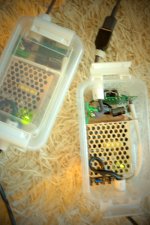
//
I then built 2pcs of 5V supplies based on Meanwell 15V smps (@12) -> a 5V zener -> an RCRC filter -> a PO89ZB filter -> an ldovr LT3045 reg; now it all got really nice.
I'm really happy with this.

//
The order is actually: Meanwell 15V smps (@12) -> a PO89ZB filter -> a 5V zener -> an RCRC filter -> an ldovr LT3045 reg.
//
//
Made a new round of measurements and filters. I had an idea that I could use the 4 backwards reflecting woofers per speaker to add some broadening of the directivity in the higher half part of the speaker to match that of the lower. I made a new filter with low level high shelf to accommodate the increased energy upwards. So no XO for this "way"...

... and seeing the other...

This sound wise seemed quite promising to me so I continued to make a full implementation which in the end measured as follows 70cm from WG mouth. Levels not calibrated.
Please mind the scales:

Still some room for improvements around 1k 🙂 XO tries to be 1,6k ... the steepness towards the low level shelf dont match the HF one..
//
... and seeing the other...
This sound wise seemed quite promising to me so I continued to make a full implementation which in the end measured as follows 70cm from WG mouth. Levels not calibrated.
Please mind the scales:
Still some room for improvements around 1k 🙂 XO tries to be 1,6k ... the steepness towards the low level shelf dont match the HF one..
//
Attachments
Last edited:
Distortion at calibrated levels:

Measurement setup: 70cm to WG mouth.
Low frequency levels are not surprising given that there is 4 pcs of 4" woofers in a too small closed box playing 🙂


Just to verify that it is not the HF part that is contributing


200 and up looks quite good ;-) but would lie to see 1k region drop to 0,1% ...
//
Measurement setup: 70cm to WG mouth.
Low frequency levels are not surprising given that there is 4 pcs of 4" woofers in a too small closed box playing 🙂
Just to verify that it is not the HF part that is contributing
200 and up looks quite good ;-) but would lie to see 1k region drop to 0,1% ...
//
Last edited:
Hi, you could try increasing impedance to see if the midrange distortion reduces 🙂 Quick test would be to just put resistor on speaker input and see if it affects the distortion bump there. If it does, you could then individually test both mids and tweet which one is it and perhaps come up with more permanent solution. If not, it's likely some resonance / noise.
The source of the distortion was already determined if you check what I posted.
8ohm Resistor on the LF "way" (HF off!):

No resistor - I adjusted the level son that the 1k regions was the same for the two measurements.

A small difference in favour of the resistor, distortion wise - the peak at 1,3 was not effected. One also see the impact on the FR - but no problem to EQ out...
//
8ohm Resistor on the LF "way" (HF off!):
No resistor - I adjusted the level son that the 1k regions was the same for the two measurements.
A small difference in favour of the resistor, distortion wise - the peak at 1,3 was not effected. One also see the impact on the FR - but no problem to EQ out...
//
Last edited:
For those of us without 3d printers- cardstock can make fins too, fit two pieces together in an X and trim to fit, it really isn't too hard. Once it press fits reasonably well, stiffen the cardstock with some glue, I use wood glue, and once it's dry you can see if it'll still press fit comfortably and trim for final fit. If you're unhappy it's cheap to make another. Mine have all taken <1h to make a pair and stayed press-fit with no additional adhesive (in tweeter horns at home levels).
Fair enough @TNT
The fins I'm thinking of
I'm saying that it's easy to make 2 interlocking pieces out of card stock and trim to fit (and easy to duplicate from the pattern) and stabilize them with some added firm-drying glue. The semi-flexible nature of woodglue, like titebond or similar, makes it a little flexible and easy to press-fit.
The fins I'm thinking of
I'm saying that it's easy to make 2 interlocking pieces out of card stock and trim to fit (and easy to duplicate from the pattern) and stabilize them with some added firm-drying glue. The semi-flexible nature of woodglue, like titebond or similar, makes it a little flexible and easy to press-fit.
- Home
- Loudspeakers
- Multi-Way
- Hornflower 2-way point source
